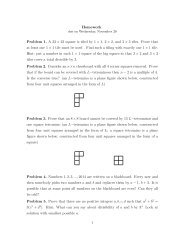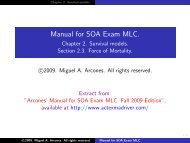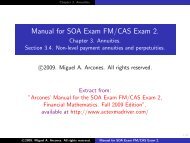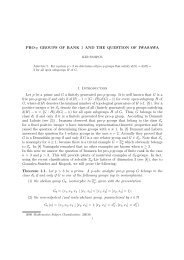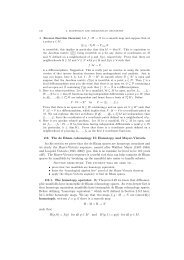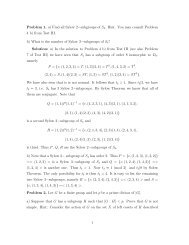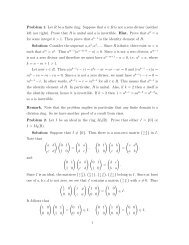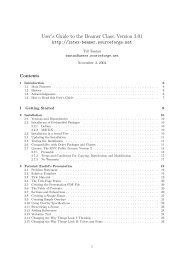Create successful ePaper yourself
Turn your PDF publications into a flip-book with our unique Google optimized e-Paper software.
Chapter <strong>2.</strong> Cashflows.<br />
<strong>Manual</strong> <strong>for</strong> <strong>SOA</strong> <strong>Exam</strong> <strong>FM</strong>/<strong>CAS</strong> <strong>Exam</strong> <strong>2.</strong><br />
Chapter <strong>2.</strong> Cashflows.<br />
Section <strong>2.</strong>3. Yield rates.<br />
c○2009. Miguel A. Arcones. All rights reserved.<br />
Extract from:<br />
”Arcones’ <strong>Manual</strong> <strong>for</strong> the <strong>SOA</strong> <strong>Exam</strong> <strong>FM</strong>/<strong>CAS</strong> <strong>Exam</strong> 2,<br />
Financial Mathematics. Fall 2009 Edition”,<br />
available at http://www.actexmadriver.com/<br />
c○2009. Miguel A. Arcones. All rights reserved. <strong>Manual</strong> <strong>for</strong> <strong>SOA</strong> <strong>Exam</strong> <strong>FM</strong>/<strong>CAS</strong> <strong>Exam</strong> <strong>2.</strong><br />
1/16
Yield of return<br />
Chapter <strong>2.</strong> Cashflows. Section <strong>2.</strong>3. Yield rates.<br />
Suppose that the future value at time t of the cashflow:<br />
Investments V0 C1 C2 · · · Cn<br />
Time 0 t1 t2 · · · tn<br />
is FV . Then, the rate of return i of the investment satisfies the<br />
equation,<br />
FV = V0ν −t +<br />
n�<br />
j=1<br />
Cjν tj −t = V0(1 + i) t +<br />
n�<br />
Cj(1 + i) t−tj .<br />
The rate of return i, i > −1, solving this equation is called the<br />
yield rate of return or internal rate of return. This equation<br />
can have either no solutions, or one solution, or several solutions.<br />
We are interested in values of i with i > −1. If i < −1, then<br />
(1 + i) n > 0 is n is even and (1 + i) n < 0 is n is odd. Values of i<br />
with i ≤ −1 do not make any sense.<br />
j=1<br />
c○2009. Miguel A. Arcones. All rights reserved. <strong>Manual</strong> <strong>for</strong> <strong>SOA</strong> <strong>Exam</strong> <strong>FM</strong>/<strong>CAS</strong> <strong>Exam</strong> <strong>2.</strong><br />
2/16
Chapter <strong>2.</strong> Cashflows. Section <strong>2.</strong>3. Yield rates.<br />
<strong>Exam</strong>ple 1<br />
Suppose that John invest $3000 in a business. One year later,<br />
John sells half of this business to a partner <strong>for</strong> $6000. Two years<br />
after the beginning, the business is in red and John has to pay<br />
$4000 to close this business. What is the rate of interest John’s<br />
got in his investment?<br />
c○2009. Miguel A. Arcones. All rights reserved. <strong>Manual</strong> <strong>for</strong> <strong>SOA</strong> <strong>Exam</strong> <strong>FM</strong>/<strong>CAS</strong> <strong>Exam</strong> <strong>2.</strong><br />
3/16
Chapter <strong>2.</strong> Cashflows. Section <strong>2.</strong>3. Yield rates.<br />
<strong>Exam</strong>ple 1<br />
Suppose that John invest $3000 in a business. One year later,<br />
John sells half of this business to a partner <strong>for</strong> $6000. Two years<br />
after the beginning, the business is in red and John has to pay<br />
$4000 to close this business. What is the rate of interest John’s<br />
got in his investment?<br />
Solution: The cashflow is:<br />
Inflow −3000 6000 −4000<br />
Time 0 1 2<br />
Since John lost money, one expect that i is negative. However,<br />
there is no solution. We have to solve<br />
−3000(1 + i) 2 + 6000(1 + i) − 4000 = 0, or<br />
3(1 + i) 2 − 6(1 + i) + 4 = 0. Using the quadratic <strong>for</strong>mula,<br />
There is no solution.<br />
1 + i = 6 ± √ 6 2 − 4 · 4 · 3<br />
2<br />
= 6 ± √ −12<br />
.<br />
2<br />
c○2009. Miguel A. Arcones. All rights reserved. <strong>Manual</strong> <strong>for</strong> <strong>SOA</strong> <strong>Exam</strong> <strong>FM</strong>/<strong>CAS</strong> <strong>Exam</strong> <strong>2.</strong><br />
4/16
Chapter <strong>2.</strong> Cashflows. Section <strong>2.</strong>3. Yield rates.<br />
<strong>Exam</strong>ple 2<br />
What is the yield rate on a transaction in which a person makes<br />
payments of $100 immediately and $100 at the end of two years,<br />
in exchange <strong>for</strong> a payment of $201 at the end of one year? Find all<br />
possible solutions.<br />
c○2009. Miguel A. Arcones. All rights reserved. <strong>Manual</strong> <strong>for</strong> <strong>SOA</strong> <strong>Exam</strong> <strong>FM</strong>/<strong>CAS</strong> <strong>Exam</strong> <strong>2.</strong><br />
5/16
Chapter <strong>2.</strong> Cashflows. Section <strong>2.</strong>3. Yield rates.<br />
<strong>Exam</strong>ple 2<br />
What is the yield rate on a transaction in which a person makes<br />
payments of $100 immediately and $100 at the end of two years,<br />
in exchange <strong>for</strong> a payment of $201 at the end of one year? Find all<br />
possible solutions.<br />
Solution: The cashflow is:<br />
Inflow −100 201 −100<br />
Time 0 1 2<br />
We have to solve −100 + 201(1 + i) −1 − 100(1 + i) −2 = 0, or<br />
100(1 + i) 2 − 201(1 + i) 1 + 100 = 0. Using the quadratic <strong>for</strong>mula,<br />
1 + i = 201 ± √ 201 2 − 4 · 100 · 100<br />
200<br />
= 201 ± √ 201<br />
.<br />
200<br />
The two solutions are i = 10.5124922% and i = −9.512492197%.<br />
c○2009. Miguel A. Arcones. All rights reserved. <strong>Manual</strong> <strong>for</strong> <strong>SOA</strong> <strong>Exam</strong> <strong>FM</strong>/<strong>CAS</strong> <strong>Exam</strong> <strong>2.</strong><br />
6/16
Chapter <strong>2.</strong> Cashflows. Section <strong>2.</strong>3. Yield rates.<br />
Since the internal rate of return could either do not exist or have<br />
several solutions, it is not a good indication of the per<strong>for</strong>mance of<br />
general investment strategy. However there exists a unique rate of<br />
return i with i > −1 if either all outflows happen be<strong>for</strong>e all the<br />
inflows, or all inflows happen be<strong>for</strong>e all the outflows.<br />
c○2009. Miguel A. Arcones. All rights reserved. <strong>Manual</strong> <strong>for</strong> <strong>SOA</strong> <strong>Exam</strong> <strong>FM</strong>/<strong>CAS</strong> <strong>Exam</strong> <strong>2.</strong><br />
7/16
Chapter <strong>2.</strong> Cashflows. Section <strong>2.</strong>3. Yield rates.<br />
Suppose that you an investment strategy consisting of investing<br />
(positive) payments of C1, . . . , Cm at times t1 < · · · < tm. At<br />
times s1 < · · · < sn, we get respective (positive) returns<br />
P1, . . . , Pn, where s1 > tm. The cashflow is<br />
Inflows −C1 −C2 · · · −Cm P1 P2 · · · Pn<br />
Time t1 t2 · · · tm s1 s2 · · · sn<br />
In this case, there exists a unique solution to the equation<br />
n�<br />
Pk(1 + i) −sk −<br />
k=1<br />
m�<br />
Cj(1 + i) −tj = 0, i > −1.<br />
j=1<br />
Besides,<br />
◮ �n k=1 Pk > �m j=1 Cj, then i > 0.<br />
◮ �n k=1 Pk < �m j=1 Cj, then i < 0.<br />
◮ �n k=1 Pk = �m j=1 Cj, then i = 0.<br />
c○2009. Miguel A. Arcones. All rights reserved. <strong>Manual</strong> <strong>for</strong> <strong>SOA</strong> <strong>Exam</strong> <strong>FM</strong>/<strong>CAS</strong> <strong>Exam</strong> <strong>2.</strong><br />
8/16
Chapter <strong>2.</strong> Cashflows. Section <strong>2.</strong>3. Yield rates.<br />
<strong>Exam</strong>ple 3<br />
As the budgeting officer <strong>for</strong> Road Kill Motors Inc., you are<br />
evaluating the purchase of a new car factory. The cost of the<br />
factory is $4 million today. It will provide inflows of $1.4 million at<br />
the end of each of the first three years. Find the effective rate of<br />
interest which this investment will provide your company.<br />
c○2009. Miguel A. Arcones. All rights reserved. <strong>Manual</strong> <strong>for</strong> <strong>SOA</strong> <strong>Exam</strong> <strong>FM</strong>/<strong>CAS</strong> <strong>Exam</strong> <strong>2.</strong><br />
9/16
Chapter <strong>2.</strong> Cashflows. Section <strong>2.</strong>3. Yield rates.<br />
<strong>Exam</strong>ple 3<br />
As the budgeting officer <strong>for</strong> Road Kill Motors Inc., you are<br />
evaluating the purchase of a new car factory. The cost of the<br />
factory is $4 million today. It will provide inflows of $1.4 million at<br />
the end of each of the first three years. Find the effective rate of<br />
interest which this investment will provide your company.<br />
Solution: The cashflow is<br />
Contributions −4 1.4 1.4 1.4<br />
Time 0 1 2 3<br />
An equation of value <strong>for</strong> the cashflow is<br />
0 = 4 − (1.4)(1 + i) −1 − (1.4)(1 + i) −2 − (1.4)(1 + i) −3 .<br />
In the TI–BA–II–Plus calculator, we can find i, by going to CF ,<br />
and enter CFo =−4, C01 =1.4, F01 =3, 2nd , QUIT . We can<br />
move between different entries using the arrows ↓ and ↑ . Press<br />
IRR CPT and get IRR = i = <strong>2.</strong>47974%.<br />
c○2009. Miguel A. Arcones. All rights reserved. <strong>Manual</strong> <strong>for</strong> <strong>SOA</strong> <strong>Exam</strong> <strong>FM</strong>/<strong>CAS</strong> <strong>Exam</strong> <strong>2.</strong><br />
10/16
Chapter <strong>2.</strong> Cashflows. Section <strong>2.</strong>3. Yield rates.<br />
<strong>Exam</strong>ple 4<br />
Find the internal rate of return such that a payment of 400 at the<br />
present, 200 at the end of one year, and 300 at the end of two<br />
years, accumulate to 1000 at the end of 3 years.<br />
c○2009. Miguel A. Arcones. All rights reserved. <strong>Manual</strong> <strong>for</strong> <strong>SOA</strong> <strong>Exam</strong> <strong>FM</strong>/<strong>CAS</strong> <strong>Exam</strong> <strong>2.</strong><br />
11/16
Chapter <strong>2.</strong> Cashflows. Section <strong>2.</strong>3. Yield rates.<br />
<strong>Exam</strong>ple 4<br />
Find the internal rate of return such that a payment of 400 at the<br />
present, 200 at the end of one year, and 300 at the end of two<br />
years, accumulate to 1000 at the end of 3 years.<br />
Solution: The cashflow is<br />
Contributions −400 −200 −300 1000<br />
Time 0 1 2 3<br />
An equation of value <strong>for</strong> the cashflow is<br />
0 = −400(1 + i) 3 − 200(1 + i) 2 − 300(1 + i) + 1000.<br />
In the TI–BA–II–Plus calculator, we can find i, by going to CF ,<br />
and enter CFo =−400, C01 =−200, F01 =1, C02 =−300,<br />
F02 =1, C03 =1000, F03 =1, 2nd , QUIT . We can move<br />
between different entries using the arrows ↓ and ↑ . Press IRR<br />
CPT and get IRR = 5.0709%.<br />
c○2009. Miguel A. Arcones. All rights reserved. <strong>Manual</strong> <strong>for</strong> <strong>SOA</strong> <strong>Exam</strong> <strong>FM</strong>/<strong>CAS</strong> <strong>Exam</strong> <strong>2.</strong><br />
12/16
Chapter <strong>2.</strong> Cashflows. Section <strong>2.</strong>3. Yield rates.<br />
<strong>Exam</strong>ple 5<br />
An investment fund is established at time 0 with a deposit of<br />
$5000. $6000 is added at the end of 6 months. The fund value,<br />
including interest, is $11500 at the end of 1 year. Find the internal<br />
rate of return as a annual nominal rate convertible semiannually.<br />
c○2009. Miguel A. Arcones. All rights reserved. <strong>Manual</strong> <strong>for</strong> <strong>SOA</strong> <strong>Exam</strong> <strong>FM</strong>/<strong>CAS</strong> <strong>Exam</strong> <strong>2.</strong><br />
13/16
Chapter <strong>2.</strong> Cashflows. Section <strong>2.</strong>3. Yield rates.<br />
<strong>Exam</strong>ple 5<br />
An investment fund is established at time 0 with a deposit of<br />
$5000. $6000 is added at the end of 6 months. The fund value,<br />
including interest, is $11500 at the end of 1 year. Find the internal<br />
rate of return as a annual nominal rate convertible semiannually.<br />
Solution: The cashflow is<br />
Investments 5000 6000 11500<br />
Time (in half years) 0 1 2<br />
An equation of value <strong>for</strong> the cashflow is<br />
� �−1 �<br />
i (2)<br />
0 = (5000) + (6000) 1 + − (11500) 1 +<br />
2<br />
�−2 i (2)<br />
.<br />
2<br />
In the TI–BA–II–Plus calculator, press CF , and enter<br />
CFo =5000, C01 =6000, F01 =1, C02 =−11500, F02 =1.<br />
Press IRR , CPT and get IRR =<br />
i (2)<br />
2<br />
= 3.095064303% and<br />
i (2) = 6.190128606%. The six–month effective interest rate is<br />
c○2009. Miguel A. Arcones. All rights reserved. <strong>Manual</strong> <strong>for</strong> <strong>SOA</strong> <strong>Exam</strong> <strong>FM</strong>/<strong>CAS</strong> <strong>Exam</strong> <strong>2.</strong><br />
i (2)<br />
2 .<br />
14/16
Chapter <strong>2.</strong> Cashflows. Section <strong>2.</strong>3. Yield rates.<br />
<strong>Exam</strong>ple 6<br />
An investment fund is established at time 0 with a deposit of<br />
$5000. $6000 is added at the end of 6 months. The fund value,<br />
including interest, is $11500 at the end of 1 year. Find the internal<br />
rate of return as a annual nominal rate convertible monthly.<br />
c○2009. Miguel A. Arcones. All rights reserved. <strong>Manual</strong> <strong>for</strong> <strong>SOA</strong> <strong>Exam</strong> <strong>FM</strong>/<strong>CAS</strong> <strong>Exam</strong> <strong>2.</strong><br />
15/16
Chapter <strong>2.</strong> Cashflows. Section <strong>2.</strong>3. Yield rates.<br />
<strong>Exam</strong>ple 6<br />
An investment fund is established at time 0 with a deposit of<br />
$5000. $6000 is added at the end of 6 months. The fund value,<br />
including interest, is $11500 at the end of 1 year. Find the internal<br />
rate of return as a annual nominal rate convertible monthly.<br />
Solution: The cashflow is<br />
Investments 5000 6000 11500<br />
Time (in months) 0 6 12<br />
An equation of value <strong>for</strong> the cashflow is<br />
� �−6 �<br />
i (12)<br />
0 = (5000) + (6000) 1 + − (11500) 1 +<br />
12<br />
�−12 i (12)<br />
.<br />
12<br />
In the TI–BA–II–Plus calculator, press CF , and enter<br />
CFo =5000, C01 =0, F01 =5, C02 =6000, F02 =1, C03 =0,<br />
F03 =5, C04 =−11500, F04 =1. Press IRR , CPT and get<br />
IRR =<br />
i (12)<br />
12 = 0.509314804% and i (12) = 6.111777648%.<br />
c○2009. Miguel A. Arcones. All rights reserved. <strong>Manual</strong> <strong>for</strong> <strong>SOA</strong> <strong>Exam</strong> <strong>FM</strong>/<strong>CAS</strong> <strong>Exam</strong> <strong>2.</strong><br />
16/16



